
To be a great angler, there are certain skills you just have to perfect, a rite of passage, if you like.
These three may take a little time and practice to master, but they’re well worth the effort and will surely show a great return on your investment.
1) Walk the Dog
The “walking the dog” technique is a fabulous topwater retrieve for spooks, pencil pops, and frogs. Work the rod correctly and the bait swings side to side on a dime across the surface. Bassmaster legend Charlie Campbell of Missouri was a true master of this retrieve and his advice still rings true for perfecting this complicated technique: both hands must work in sync. Casting or spinning gear can be used, but many have greater success with a baitcaster.
Here’s how to walk the dog:


The heavy cover workaround

Heavy cover demands long, heavy-action rods. So, instead of working the rod downward in the traditional way, elevate the rod tip and work the rod upward. The rod’s length and heavy action, matched with no-stretch braided line allows the angler to impart the same lure action with simple flicks of the rod tip.
Another advantage of having the rod tip up high is a delayed hook-set. When the hit occurs, drop the rod tip, make several reel cranks and then set the hook, which usually ensures better hooking.
Top tips
• To create an effortless retrieve you need slack line. Determining the right amount of slack will come with experience.
• To make a short, jumpy retrieve use weak wrist snaps and full reel turns. This limits the amount of slack line, which restricts the lure’s side to side sweep.
• If the lure moves in a straight line instead of cutting right and left, you’re reeling too quickly.
• To really work over a likely spot or to call back a bass, use exaggerated swings.
• The pros can make a lure’s nose dance while keeping the bait stationary. This neat trick is done by limiting your reel turns or stopping them altogether. Snap the wrist repeatedly with minimal cranking to keep the bait active without pulling it away from the strike zone.
Shorter rods get the nod
Charlie Campbell taught the world how to walk the dog using a pistol-grip 5½′ rod, which doesn’t exist anymore, but sticking to a 6′ or 6′ 6″ medium or medium/heavy rod is best when making mid-range casts. Unless you’re very tall, a longer rod forces you to snap the rod sideways instead of downward, which often moves too much line and results in an awkward lure action.
2) Stroking a jig
Stroking a jig is one of the most underused techniques, which is too bad because this snappy, erratic retrieve makes jigs come alive. It’s not difficult to perfect and it’s an effective deep-water approach.
Diehard spinning anglers can make this work, but make sure you have the correct rod action. Wimpy rods absorb all the snap, destroying the lure’s action. Reels with a quick gear ratio are key to keeping a quick rhythm, as is collecting the slack line quickly. Catching up with wild fish is a real asset.
Here’s how to stroke a jig:

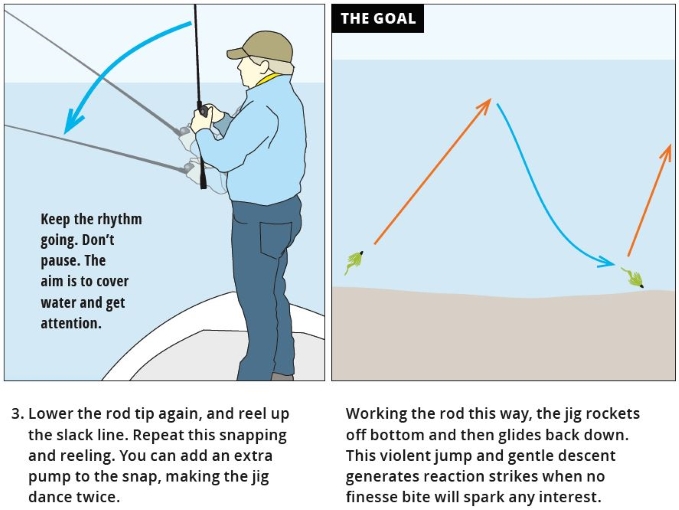
Top tips
• The bite usually comes on the slack-line fall. Bass will often engulf it without alerting the angler, so always be ready to set the hook as you prepare for the next rod snap.
• Avoid putting rod pressure on the line and try to feel the bait as it falls. Slack line allows the bait to do its magic.
• Line watching is helpful for detecting a strike, but don’t let it slow you down; keep the retrieve snappy and quick. Bass will either eat it or they won’t. Many times, as you lift up to make the next stroke, you’ll feel the heft of the fish.
• Stroking works well on flats or over deep water. Focus on less snaggy areas as these heavy jigs will wedge in tangles. Sand or smooth gravel and even light weedbeds are excellent choices, as they are natural habitat for crayfish and feeding bass.
Good gear
• Use a heavy action 7′ to 7′,4″ casting rod spooled with 15- to 20-lb fluorocarbon.
• Err on the heavy side when stroking jigs; this isn’t a finesse deal. Heavier jigs will have the bait back on bottom quickly, ready for the next rod snap.
• A ½ oz. flipping jig has always been the traditional choice but tubes, hair jigs, spoons, and even swimbaits work equally well. Having a few jigs in 5⁄8 oz. and 3⁄4 oz. will allow for fine tuning.
3) Skipping
Skipping is my favourite technique. I’ve made a lot of money in tournaments using it. (Too bad the guys I’ve taught have made a lot more than me!) Skipping is exactly like throwing a flat stone across the water, except you’re skipping a lure.
Snapping a bait puts lures in places no other technique can: under docks, trees, boat houses, and any other structure bass use for cover. The beauty of this cast is that the angler can position themselves further back than flipping or pitching would allow, with no loss of accuracy.
Many anglers make this cast more complicated than it needs to be.
Here’s how to skip:
(instructions are for right handed casting. Just reverse it if you’re a lefty)
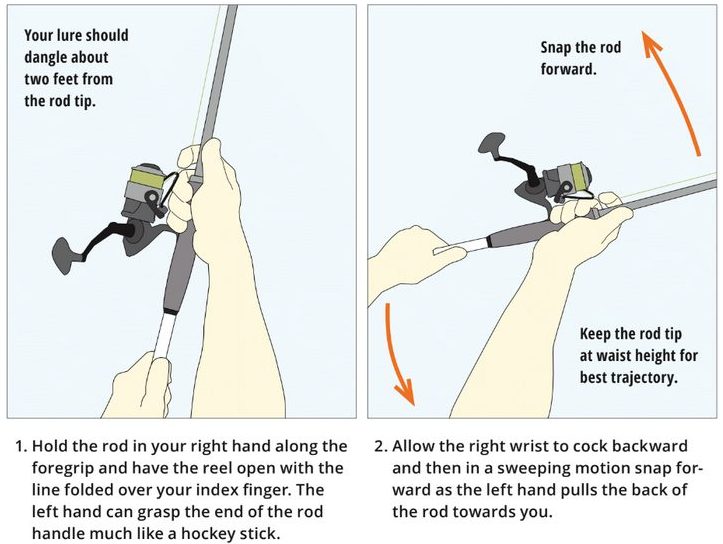

Variation for tight spots

River anglers are familiar with this cast. It’s ideal when two anglers are both skipping at the front of the boat, or if you’re trapped in the middle between fishing buddies.
1. Hold the rod in your right hand, and the line in your left hand about two feet to the side of the reel, with the reel open.
2. With a quick and forceful snap of the right wrist, bring the rod across your body backward and then forward.
3. Open the left hand to release the line just as the rod tip is about to reach the end of the cast. It’s exactly like pitching with baitcasting but this time the lure is allowed to skip along the water to the target. You really need to snap the wrist to achieve any distance.
Before you skip
• Start with spinning gear; it’s by far the easiest to use.
• Position yourself on the side of the boat you intend to cast on. Right-handers need to be on the right side. This gives you casting room.
• Position the boat so you’re working the cover or shoreline from right to left to give yourself room. Otherwise, you might whack the trolling motor, windshield, or even your buddy.
• Stand up tall. Don’t kneel or crouch.
1. Hold the rod in your right hand along the foregrip and have the reel open with the line folded over your index finger. The left hand can grasp the end of the rod handle much like a hockey stick.
2. Allow the right wrist to cock backward and then in a sweeping motion snap forward as the left hand pulls the back of the rod towards you.
3. Release the line just as the rod is about to finish its horizontal motion; it’s more of a wrist shot than a slap shot.
Done well, your bait should skip along the surface of the water to reach well under overhanging cover.
Top tips
• Avoid dragging the rod tip too close to the water as the lure will start to skip too early and quickly lose momentum. The best skips rocket bait far under overhanging cover.
• If the lure isn’t reaching the target, try incorporating a roll into your cast for more speed and distance. As you bring the rod backwards, roll your wrist counter-clockwise and then make the horizontal cast. This will deliver more momentum.
• Reels with full spools always cast further and easier.
• Skipping can produce some nasty bird nests. Large loops form very easily when braided line is cranked onto the reel without tension. A simple solution is to manually flip the bail over. Another fix is to pick up the line and place it under the index finger of the hand holding the rod before turning the reel. By providing tension, the line will wrap onto the spool smoothly without forming any knots.
Good gear
Tackle set-up is crucial. Many make the mistake of selecting a rod that’s too short or wimpy.
• The best set-up is a medium-heavy 6′10″ rod, casting or spinning. The length will generate more casting power and control large fish. If you’re struggling, try a medium-action rod with a more wimpy tip.
• Braided or fused line is ideal, as it comes off the spool easily. For fused line, stick to 20-pound test. Braid can range from 20- to 40-pound test, and avoid super-thin as it will dig into the spool and tangle horribly.
• The easiest lure is a weightless Texas or wacky rigged senko style bait, especially on spinning tackle.
• A weightless, Texas-rigged tube or fluke is a close second.
• Almost any bait can be skipped, but compact, streamlined baits are far easier.
• Soft-plastic baits with lots of legs or a long profile tend to tumble instead of skip.
• If you reach Chuck Norris level, you can try skipping chatterbaits, buzzbaits, or spinnerbaits with casting gear.

Luigi’s love affair with angling started when he was a lad and has never faltered. When not gawking at lures, he can be found setting goose or turkey decoys, or in a tree stand. Reach Luigi at [email protected]
Originally published in the July 2019 issue of Ontario OUT of DOORS.


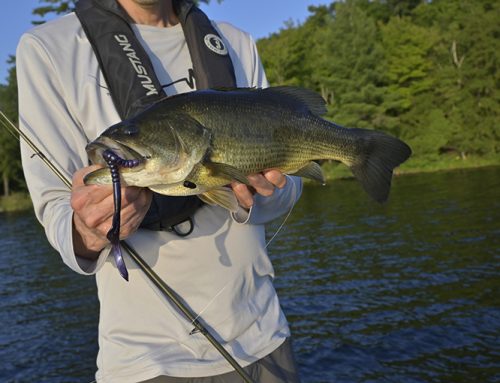
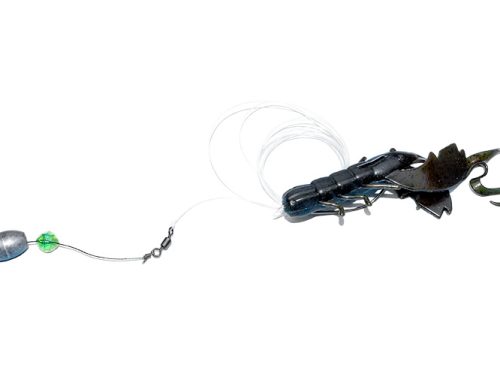
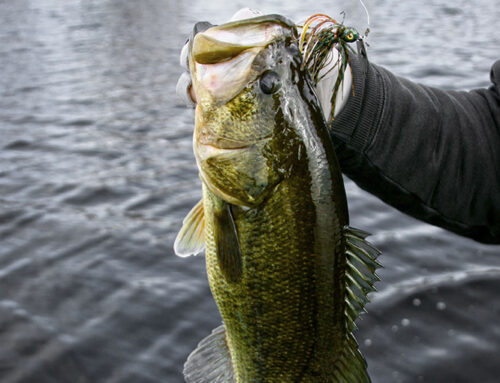
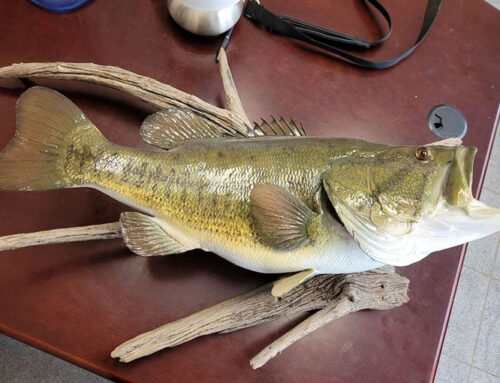
Leave A Comment